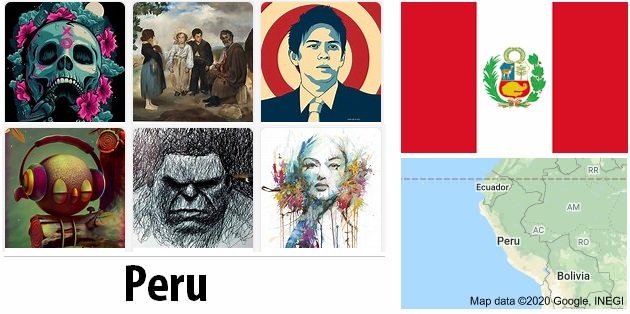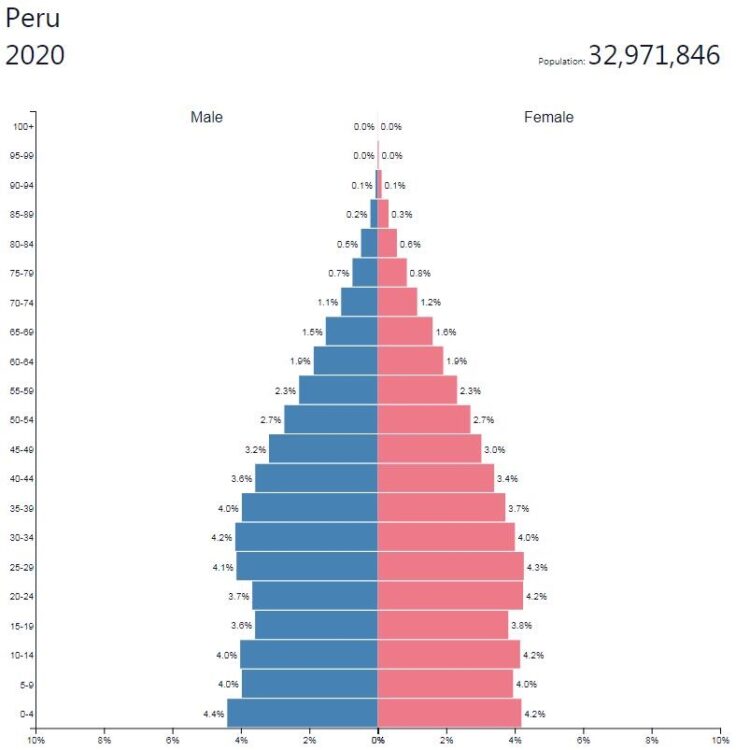Literature
The chroniclers Pedro Cieza de León, Agustín de Zárate and Pedro Sarmiento de Gamboa depicted the Spanish conquest of Peru in the 16th century and helped to shape the image of the Incarct. Peru received an excellent master writer in Garcilaso de la Vega early on, nicknamed El Inca. His “Comentarios reales” (1609) and “Historia general del Perú” (1617) tell of life in Peru.
- Countryaah: Population and demographics of Peru, including population pyramid, density map, projection, data, and distribution.
Towards the end of the 19th century Ricardo Palma portrayed Peru’s history in fictional form with his “Tradiciones peruanas”. In poetry, the hungry national poet José Santos Chocano became the pioneer of modernism. Inward stranger José María Eguren, however, came to exert greater influence on the rich Peruvian poetry, whose chief representative, César Vallejo, one of the 20th century’s greatest poets in Latin America, was treated so poorly that he left the country. In the 1930’s and 1940’s, a number of lyrical talents appeared in Peru: Emilio Adolfo Westphalia, Javier Sologuren and Carlos Germán Belli, who were later followed by the early deaths of Javier Heraud and Antonio Cisneros.
In the 1900’s, Ciro Alegría, José María Arguedas and Manuel Scorza wrote about the harsh conditions for the indigenous peoples of the Andes. Arguedas also recorded and translated popular quechual literature. Alfredo Bryce Echenique has portrayed the Peruvian upper class with humor and critical acuity. Mario Vargas Llosa, one of the most well-known authors of the electric boom, in his novels usually deals with brutal Peruvian reality. Other important prose writers are Julio Ramón Ribeyro and Enrique Congrains Martín. Two politically radical essays, Manuel González Prada and José Carlos Mariátegui, have exerted influence far beyond Peru’s borders.
Drama and theater
The sometimes lively theater life of Lima produced two significant playwrights during the 1600’s: the satirical Juan del Valle Caviedes and the Zarzuelin-influenced Lorenzo de las Llamosas. In the 19th century, Felipe Pardo y Aliaga and Manuel Asencio Segura portrayed Peruvian life with irony and critical acuity. In modern times, a renewal of the theater in Peru was initiated by the arrival of Spanish actress Margarita Xirgú in 1946, when Sebastián Salazar Bondy also broke through with his ironic and satirical plays about the route unit in Peruvian society.
Art
For the oldest art and architecture in Peru see ancient American art and architecture and Inca.
European mannerism was introduced in Peru by the Italian Bernardo Bitti towards the end of the 16th century. With the Italians Mateo Péres and Angelino de Medoro, the Baroque began in the early 17th century. A few years later, the indigenous artist Diego Quispe founded Tito Escuela de Cuzco. In the 18th century, the Spaniard Francisco Martínez and the Peruvian Cristóbal Lozano became representatives of Escuela de Lima. After Peru became independent, José Gil de Castro, who painted portraits of freedom fighters like Bolívar and San Martín, appeared. The first to describe motifs related to pre-Columbian cultures was Francisco Laso. Unlike other countries in the region, Peru lacked an official art academy even during the 19th century (it was first founded in 1918).
In the early 1900’s, several intellectuals started a movement called indigenismo. José Sabogal became one of the movement’s foremost representatives. He was influenced by Mexican muralism and depicted the social conditions of the indigenous people in realistic paintings. He was followed by Camilo Blas and Ricardo Flores. The most renowned of those who developed a non-realistic painting in Peru was Fernando de Szyszlo, who in the 1940’s began to integrate abstract and pre-Columbian elements. De Szyszlo’s artistry was very important for the development of modernism in Peru.
Architecture
At the beginning of the colonial era, the Spaniards built on older Inca buildings, e.g. the Santo Domingo Monastery in Cuzco was built over Inka’s Sun Temple. Towards the end of the 16th century, the cathedrals of Lima (1598–1622) and Cuzco (1598–1654) began, both in the Renaissance style. In the mid-17th century, the Baroque style spread throughout Peru. Typical Baroque churches are San Francisco (1657–74) in Lima and Compañía (1651–68) in Cuzco. Local Baroque schools emerged in Cajamarca and Arequipa.
After some influence from neoclassicalism in the 19th century, the so-called neo-colonial style was built in the early 1900’s. Palacio del Arzobispado (1916) in Lima. Modernism’s breakthrough in Peru occurred in 1947, when a group of architects and artists formed the group Agrupación Espacio. They advocated a functionalist architecture and combined natural materials with large glass surfaces.
Music
Classical music
During colonial times, art music was cultivated according to European ideals mainly at the cathedrals of Lima and Cuzco. At the end of the 19th century, composers such as Luis Duncker Lavalle (1874–1922) and Teodoro Valcárcel (1902–42) became interested in domestic music. Daniel Alomía Robles (1871-1942) recorded a large number of popular tunes and in 1913 set up the opera “El cóndor pasa”, which included the tune that became world famous in 1970. Later composers, such as Celso Garrido Lecca (born 1926) and Pozzi Escot (born 1933), has often been active abroad.
Folk music and popular music
In the Andean area, end-blown quena type flutes have existed since the chavin culture. From the paracas culture have been found clay trumpets and pan flute (siku). Among the percussion are bells, rattles and drum tinya. Of quechuaur origin, the singing styles are arawi and taki, while wayñu and quashwa are dance styles. All usually have pentatonic melody and two-beat rhythms.
Spanish dances, poetic forms and instruments have often been mixed with pre-Columbian features. With instruments such as guitar, harp, violin and mandolin- like bandurria also came the European harmony.
Peru’s variant of neighboring countries dance cueca is called marinera. The Peruvian drum is also appreciated in other Spanish-speaking countries.
In connection with Lima’s modernization process around 1900, a popular genre called música criolla developed from European, Andean and African styles. This genre, which included rhythms and dances such as drum, polka, tondero and marina, came to be perceived as genuine folk culture. Popular artists were the trio Los Embajadores Criollos (formed in 1949) and the duo Los Troveros Criollos (formed in 1952).
Native American singer Yma Sumac, with her exceptional vocal range, became internationally famous during the 1950’s in the genre exotica.
With post-war urbanization, commercialization of Andean music followed with huayno as one of the most popular genres. During the 1960’s, a form of huayano developed with cumbia rhythm and rock instruments, called chicha or peruvian cumbia, which appealed to a young audience.
During the 1980’s and 1990’s, chicha was the largest popular music style in Peru with representatives such as the Los Shapis group (formed in 1981) and the entertainer Tongo (actually Abelardo Gutiérrez Alanya, born 1957). Later, the style has been developed in various mix forms with, for example, salsa and techno.
International rock has been played in Peru since the late 1950’s, but during the military junta of the 1970’s and 1980’s, rock music appeared only as an underground phenomenon with no media support. It was not until the late 1990’s that Peruvian rock could reach a large audience. One of the biggest bands is Líbido (formed in 1996).

